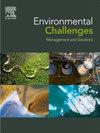东非人口、经济和环境趋势的十年分析:推进可持续发展目标12的见解
Q2 Environmental Science
引用次数: 0
摘要
保护自然,保护地球上的生命,应该成为各国和各国人民的共同事业。该研究评估了东非环境因素、经济指标和人口动态之间的复杂联系,标题为“东非人口、经济和环境趋势面板数据分析:2014年至2023年实现可持续发展目标12的见解”。通过系统地评估人口、经济和环境趋势,主要目标是提供支持可持续发展目标12(负责任的消费和生产)的见解。使用包含90个关键参数观测值的面板数据集,结果显示自然资源的平均损失率为8.9%,对应于每年2.35%的人口增长率。尽管该地区的平均GDP增长率为4.24%,但显著的差异凸显了可持续管理资源的困难。影响农业生产和资源可用性的重要气候变量包括温度、降水、相对湿度和森林面积。例如,每公顷平均谷物产量为1,902.9公斤,证明了有效的耕作方法;然而,由于气温上升和湿度波动,农业恢复能力面临风险。根据这项研究,平均二氧化碳排放量为6329.6千吨,该研究使用计量经济模型来评估这些因素之间的相关性。此外,排放与资源枯竭之间的联系表明,需要采取协调一致的战略来减轻气候变化的影响。此外,平均每立方米43.97美元的水生产力对于在环境实践和经济增长之间取得平衡至关重要。这些结果促使决策者按需制定政策,以解决该地区每个国家面临的独特经济和环境问题。本文章由计算机程序翻译,如有差异,请以英文原文为准。
A decadal analysis of demographic, economic, and environmental trends in East Africa: Insights for advancing sustainable development Goal 12
Nature, life on the planet should become a common cause for all countries and people. The study assess the complex links between environmental factors, economic indicators, and population dynamics in East Africa under the title panel data analysis of demographic, economic, and environmental trends in East Africa: insights for achieving SDG 12 from 2014 to 2023. By systematically assessing demographic, economic, and environmental trends, the main objective is to offer insights that support Sustainable Development Goal 12 (Responsible Consumption and Production). Using a panel dataset with 90 observations of key parameters, the results show an average loss of natural resources of 8.9 %, corresponding to a population growth rate of 2.35 % each year. Despite the regions 4.24 % average GDP growth, remarkably differences underscore the difficulties in managing resources sustainably. Important climatic variables that affect agricultural production and resource availability include temperature, precipitation, relative humidity, and forest area. Effective farming methods are demonstrated by the average cereal production of 1,902.9 kg per hectare, for example; yet, agricultural resilience is at risk from rising temperatures and fluctuating humidity levels. The average CO2 emissions are 6,329.6 kt according to the study, which uses econometric models to evaluate the correlations between these factors. Furthermore, the link between emissions and resource depletion suggests that coordinated strategies are required to lessen the effects of climate change. Furthermore, water productivity which averages 43.97 USD per cubic meter is essential for striking a balance between environmental practices and economic growth. These results urge made-to-order policymaking to address the distinct economic and environmental issues that each country in the region faces.
求助全文
通过发布文献求助,成功后即可免费获取论文全文。
去求助
来源期刊

Environmental Challenges
Environmental Science-Environmental Engineering
CiteScore
8.00
自引率
0.00%
发文量
249
审稿时长
8 weeks
 求助内容:
求助内容: 应助结果提醒方式:
应助结果提醒方式:


